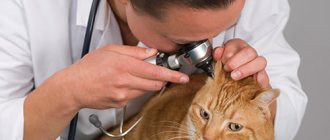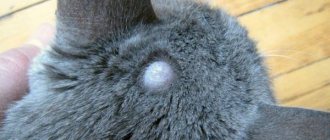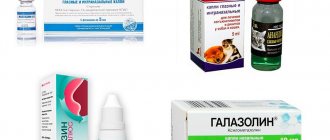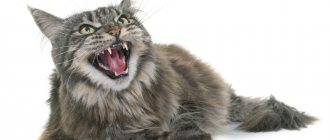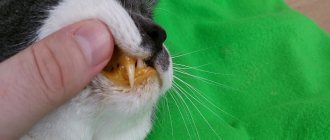The eardrum is a thin partition located between the outer and middle ear. It serves to transmit sound vibrations to the inner ear and prevent infection and foreign objects from entering.
If the integrity of the eardrum is damaged, bacteria and fungi from the external auditory canal penetrate deeper and can cause internal and otitis media. Inflammation of the inner and middle ear is a serious disease and requires immediate treatment.
Signs of a perforated eardrum in a cat
Symptoms depend on how severe the inflammation is and whether the inner ear is affected.
Most common symptoms
- The cat shakes its head
- Tilts head towards the affected ear
- Disorientation, the animal may walk in circles
- Redness and swelling of the ear
- Discharge
- Unpleasant odor from the ear canal
- Severe pain
- Hearing impairment
- Decreased activity
- Lethargy, apathy
- Horner's syndrome is characterized by a problem with the eyes.
In cases of extremely severe disease, the infection can migrate along the vestibular and facial nerves and cause meningitis and brain stem abscess, followed by the death of the pet.
Diagnosis of the disease
To diagnose problems with the eardrum, the veterinarian carefully examines the patient, assesses the condition of the external auditory canal and the degree of neurological abnormalities. When performing an otoscopy, the integrity of the eardrum is revealed, possible changes in the structure of the outer ear are identified, and the presence of a foreign object and tumor is determined.
Before the examination, the ears are washed with a sterile warm solution. An X-ray of the skull allows you to visually evaluate changes in the inner ear. Additionally, CT and MRI may be prescribed.
Clinical picture
Since otitis of the inner ear in a cat is more severe than other types, the clinical picture can be quite characteristic. Based on many signs, you can determine that your pet’s inner ear is affected and take timely measures.
In the mildest cases, the cat simply constantly touches or rubs its ears with its paws, sometimes scratching them until they bleed. Drops of exudate or blood may be observed coming out of the external auditory canal. Simply put, at first, internal otitis is no different in symptoms from average otitis. True, the ears directly suffer from internal otitis much less often. Only occasionally is their hyperemia (redness) observed; upon palpation, an increase in local body temperature can be felt.
We suggest you read: The most effective remedy for Giardia
The animal can sit in one place for a long time, shaking its head back and forth, or it can also sit with its head tilted to one side. Please note that on the side where the pet’s head is tilted, the site of the inflammatory process is located.
As the inner ear infection progresses, affected animals gradually develop facial nerve problems. In particular, this is indicated by ptosis or blepharospasm, “sagging” of the muzzle, and its pronounced unnaturalness. Severe cases are characterized by distortion of the animal's facial part, which makes the latter look like a clown with poorly applied makeup.
Signs of facial paralysis (which almost always develops in advanced cases of otitis media) also include difficulty swallowing and drinking. The worst thing is when an animal develops horizontal or vertical nystagmus, since this phenomenon directly indicates serious brain damage.
The further the pathological process progresses, the more serious the symptoms become. Thus, the animal’s gait is “wooden”, the cat cannot bend its legs, it constantly bumps into furniture, walls, people and other animals, and seizures (like epileptic seizures) are possible. In this case, you need to urgently take your pet to the veterinarian, as the consequences can be extremely severe.
How to treat cat ears
In case of severe otitis, long-term use of broad-spectrum antibiotics is indicated. After taking a smear and identifying the causative agent, antifungal drugs are prescribed. Bacteriological seeding of discharge from the ear canal helps to accurately draw up a drug treatment regimen and select antibiotics. The ear canal is sanitized with a neutral warm solution; corticosteroids are often used.
If the eardrum is slightly damaged, it recovers fairly quickly. In more severe cases, surgery will be required.
POLAR BEAR
The veterinary clinic in Nizhny Novgorod "White Bear" provides all types of services for cats and dogs. Conducts any examinations and tests in its own veterinary laboratory; the clinic operates a veterinary ambulance for animals and a 24-hour veterinarian is on call at home.
Otitis media occurs quite often in cats. Owners of such pets are not always able to assess the danger of the pathology, believing that it is easy to treat. Meanwhile, the disease can become chronic and cause the animal to completely lose hearing and even die. Information about why this disease occurs in cats, what symptoms it manifests and how it is treated will help protect your four-legged pet from serious consequences.
Therapy issues
Treating otitis media in cats at home is not only pointless, but also stupid. A seemingly mild illness can quickly develop into a severe form of the disease, when the animal can no longer be saved.
Therefore, at the first signs of otitis or suspicion of it, you should immediately seek help from a veterinarian.
Diagnostics
As a rule, at the first stage of treatment it will be proposed to conduct additional studies that will help establish the cause of the disease. It is imperative that a scraping is made from the auricle for laboratory examination of the contents.
Typically, the exudate is checked for the presence of microscopic mites in it, and it is also used to inoculate nutrient media to identify pathogenic microflora and determine sensitivity to antibiotics. Sometimes additional research methods may be required: x-rays, blood and urine tests.
Examination of the auricle
Before receiving the test results, they resort to symptomatic therapy aimed at relieving signs of the disease and getting rid of suffering. This includes:
- Cleansing the auricle from exudate and impurities, for which warm antiseptic solutions are used. The manipulation is carried out using sterile materials.
- Next, special anti-otitis drops for cats are prescribed. Usually the veterinarian makes their choice, relying on his own instincts and the results of the examination. These can be antibacterial, painkillers, hormonal drops - it all depends on the signs that are present.
- In case of severe pain, a novocaine blockade is indicated, which will not only relieve pain, but will speed up the recovery process.
How to treat otitis in a cat at the next stage depends on the established cause of the disease.
- For example, for otitis media caused by scabies mites, acaricidal ear drops for cats are prescribed.
- The presence of fungus in the contents will require the use of fungicides.
By the way! In case of fungal infections, antibiotics should never be used, as they can provoke increased proliferation of the fungus. - Infections of a bacterial nature, accompanied by profuse dirty yellow discharge and purulent otitis media in cats, require immediate treatment with antibiotics.
- In especially severe cases, it is necessary to resort to surgical intervention, which consists of puncture of the eardrum and deep treatment of the cavity with antiseptic solutions. Do not forget about active antibiotic therapy.
- Treatment of otitis in cats caused by some hormonal changes or allergies requires the use of corticosteroids, anti-stress and immunostimulating drugs.
Bacterial otitis: causes, symptoms and treatment
The inflammatory process may involve one or both ears. The disease is accompanied by:
- unbearable itching;
- discharge of dirty yellow purulent exudate;
- redness;
- an unpleasant odor that appears due to the fact that the ears are festering.
A sick kitten or adult animal becomes lethargic, apathetic, refuses to eat, and sleeps poorly due to the fact that its ears hurt and constantly itch. Microbial otitis media is treated with antibacterial drugs in the form of injections. Typically, four-legged patients are prescribed penicillins and cephalosporins. The course of antibiotic therapy is 7 days, even if the symptoms of inflammation disappear earlier.
To eliminate itching and pain, ear drops (Otibiovin, Otonazole, Aurikan) are used. To properly instill them at home, you must carefully study the instructions for use. For severe scratching, wound healing ointments (Levomekol, Iruksovetin) are used. If there is heavy purulent discharge, the ear should be washed at the veterinary clinic. If a blockage of the ear canal is detected, the help of a surgeon is sought.
Treatment, prognosis
Treatment of otitis media is complex. It begins with the obligatory cleansing of the ears from secretions (exudate, dirt) and crusts. If you neglect this procedure, the medications will not have the desired effect. Antiseptics are used for this: 3% hydrogen peroxide; solutions of Furacilin or Miramistin.
In case of purulent otitis, a deeper cleansing of the hearing aid from pus will be required, which is performed surgically in a veterinary clinic.
Among the effective ear drops are Tsipam, Otovedin, Sofradex, etc.
For inflammation caused by ticks, the veterinarian prescribes acaricidal drops. Fungal otitis will require the use of ear fungicides. Antimicrobial ear drops and antibiotics are used to treat bacterial and purulent otitis.
For allergies and hormonal changes, antihistamines and corticosteroids are used.
Advanced stages of otitis require surgical intervention - an artificial puncture, as well as deep cleansing and powerful antibiotic therapy.
Other treatments for otitis media include pain relief. In some cases, the specialist decides to use novocaine blockade and introduce detoxifiers. Regardless of the form of otitis, vitamins and immunostimulants are prescribed to increase immunity.
As for the prognosis, in the vast majority of cases, with timely treatment, it is positive.
Allergic otitis: signs and therapy
Ear inflammation in a cat can be caused by an allergic reaction. It is wrong to think that with allergies, a pet only sniffles, tears flow profusely and sneezes often. The ears are often involved in this process. When mast cells release histamine into the blood, vascular permeability increases, which can lead to changes in the natural microflora of the ear canal. As a result, the organ is attacked by all kinds of pathogenic agents. The affected ear swells, the surrounding tissue becomes watery and red.
general information
Otitis is always called inflammation of the ear. In this case, the inner ear is affected, which, among other things, includes the vestibular apparatus of the animal (to simplify everything greatly). In addition, the “deep” hearing aid is located in close proximity to the brain. It is for this reason that internal otitis is an extremely dangerous process, since the likelihood of septic damage to the central nervous system sharply increases.
This never goes away without leaving a trace; even with relatively successful treatment, there are high chances that your pet will forever remain disabled, behave inappropriately, urinate on itself, etc. In short, the rule for owners here is simple - at the first clinical signs of deep otitis media, you need to immediately take the cat to the veterinarian. The most dangerous thing is purulent otitis of the inner ear, since pus has lysing properties, that is, it can dissolve soft tissues and even bones.
Let us consider the main reasons under the influence of which animals develop such a dangerous pathology. It is almost always the result of poorly treated or untreated otitis externa/otitis media. In addition, entire colonies of ear mites sometimes lead to a similar outcome. If the animal’s body is severely weakened, parasites greatly simplify the “work” of pathogenic and conditionally pathogenic microflora.
We suggest you read: Asexual reproduction of flatworms
Often, “ordinary” allergies are to blame for the development of pathology, which appeared against the background of exposure of the animal’s body to pollen from flowering plants, components of household chemicals, animal feed, etc. The fact is that with allergies, the internal environment of the ear is greatly disturbed, which can lead to the development of pathogenic and conditionally pathogenic microflora.
Finally, internal otitis is a common consequence of foreign bodies entering the ear canal. The latter are rarely sterile. The microflora brought into the ear on the surface of the debris is highly likely to take advantage of the microtraumas left by the foreign body, as a result of which the inflammatory process will begin.
Otodectosis and parasitic otitis media
Otitis of parasitic etiology is more common in kittens than in adult cats. A sick pet experiences unbearable itching, trying to relieve it, he constantly shakes his head and scratches his ears, which often leads to the appearance of bleeding wounds on them - a gateway for pathogenic microorganisms. When examining the ear canals, you can find dark brown discharge of a crumbly consistency in them (see photo). This is nothing more than the waste products of the parasitic mite Otodectes cynotis.
Signs of an ear mite
Once in the ear canal, the parasites feed on epidermal cells and actively multiply. If there are too many of them, they move from the auricle to the scalp. Pests lead to increased sulfur production. Mechanical irritation of the skin and allergies to waste products provoke the development of an inflammatory process in the external auditory canal. It often involves pathogenic agents. Also, against the background of inflammation, pus appears. The spread of the pathological process to the eardrum is fraught with its perforation and the development of otitis media.
Treatment of the disease is aimed at eliminating parasites and concomitant bacterial or fungal infection, if there are signs of it. You should not thoughtlessly use drops with an anti-tick effect, especially if there is a violation of the integrity of the eardrum. A veterinarian must prescribe medications.
Causes
Otitis is classified according to the sections of the hearing organ (external, middle, internal), where the inflammatory focus is formed.
The most common condition in cats is otitis externa. It is successfully treated and does not cause complications. However, if the diseased ear began to be treated late, the inflammatory process spreads to the internal parts.
Otitis media also does not cause serious concern and, with adequate therapy, goes away without consequences for the body.
The most serious pathology is deep otitis media, which develops in the inner ear. The disease is fraught with serious complications such as meningitis and deafness, and death is possible.
Not a single cat is immune from otitis media. It doesn't matter how old she is or what breed she is. At risk are weakened animals and elderly individuals.
The primary signs that provoke the development of the disease include the following:
- Fleas, ticks. Parasite bites damage the skin and mucous membranes and cause inflammation.
- Water that gets into the ears becomes a favorable environment for bacteria to multiply.
- Hypothermia weakens the immune system, which cannot inhibit the development of pathogenic microorganisms.
- Foreign bodies that prevent sulfur from coming out, which leads to inflammation.
- Fungi. As fungal microorganisms decompose, they destroy the surface layers of the skin of the ears.
- Weak immunity. If a weakened body cannot cope with its protective functions, otitis media can be caused by infection, injury, metabolic disorders, etc.
- Allergies to medications, food. When a cat experiences itching, it scratches its ears, which attract bacteria.
- Injuries. Abrasions and scratches on the ears should be promptly treated with an antiseptic to prevent inflammation.
- Hormonal disorders. Deviations in any direction (lack, excess) of hormones can contribute to the occurrence of an inflammatory focus.
- Autoimmune pathologies. They are characterized by the body's immune system rejecting its own tissue cells as foreign.
- Hair in the ears. Hair growing in the ears increases the secretion of wax, causing itching and discomfort. Scratching damages the ears, causing infection and inflammation.
Primary inflammations can be complicated by yeast infections and bacterial pathogens, which leads to the occurrence of purulent otitis media.
It is also worth highlighting a number of reasons that cause inflammation of the internal parts of the ear - trauma to the skull, in particular the temporal bone, damage to the eardrum, malignant tumors inside the ear.
Fungal infection of the ear
Otitis of fungal etiology, or otomycosis, is an inflammation of the hearing organ, provoked by pathogenic or conditionally pathogenic fungi. Often this disease develops against the background of bacterial infections or ticks. The disease can be identified by unbearable itching, pain and redness. The inside of the diseased ear is almost completely covered with waste products of fungi. They look like greenish-gray cotton wool. The blockage often leads to hearing loss. Pus is released extremely rarely.
What should I do to alleviate my pet’s condition? It is necessary to clean the ear canal daily. Douching it is strictly prohibited. After cleaning, the ears should be wiped with an antiseptic alcohol solution. In the treatment of otomycosis, 1% Econazole has proven itself well. If there is a suspicion of a violation of the integrity of the eardrum, it is better to use 1 percent Tolnaftate.
Treatment of otitis media in cats at home
Self-treatment using “some drugs for otitis media” purchased independently from veterinary pharmacies can lead to irreversible consequences, so this is prohibited. Ear inflammation can be treated at home only with medications prescribed by a veterinarian. Improper treatment of otitis easily transforms its course into a chronic form.
We suggest you read: Life expectancy of a Scottish fold cat
Chronic otitis media means periodically occurring pain, constant relapses, repeated courses of medical therapy and non-stop preventive measures. At the moment of exacerbation, the disease turns a kind and affectionate pet into an aggressive animal, often not even given in to hands. This form of otitis always progresses and in the most advanced cases sometimes requires surgical intervention, which is not guaranteed to help. If you suspect that your cat has ear problems, it makes sense to immediately take her to the veterinarian.
- carefully examine the ears to determine if pain is present;
- carefully remove (cut) excess hair from the ear canal;
- Wash the ear with a cotton swab soaked in hydrogen peroxide and soak off any crusts. Lubricate the wounds with wound-healing antimicrobial ointments or a solution of brilliant green;
- drip 2-3 drops of Otinum or Otipax: drugs from a human pharmacy that have an antipruritic and analgesic effect to eliminate possible discomfort in the animal;
- Carefully clean the inside of the ears using a solution of boric acid or furatsilin. Excess moisture is wiped off with gauze napkins or soaked with loose cotton swabs;
- Apply anti-inflammatory ear drops for cats prescribed by your veterinarian.
What not to do!
- Try to clean an animal’s ears if you have never done this before!
- It is strictly forbidden to self-medicate!
- You cannot clean a cat’s ear canal without anesthesia if there are obvious signs of pain (one-time pain is enough to prevent it from being given for further examination of the ears and their treatment).
- It is not recommended to use hydrogen peroxide to clean ears, because... it causes noise when oxygen foam forms, which will frighten the animal. This solution is only suitable for external treatment of the ears.
- Do not warm affected ears.
It’s best to clean a cat’s ears together, with an assistant holding the animal for easy access to the person doing the cleaning. If there is no assistant, you will have to restrain the animal by wrapping it in a thick terry towel or blanket.
The procedure for cleaning ears during illness is unpleasant and can be painful, so you need to be prepared for the animal to struggle and scream!
- The ear is turned outward to provide access to the “insides of the ear” (this is not difficult).
- A cotton swab is dipped in any oily medicinal solution for cleaning the ears and a gentle cleaning of the cavity begins in all corners, removing large pieces of dirt and plaque, and then small ones. As the stick gets dirty, it changes. Continue the procedure until the ear is completely clean.
- The second one is cleaned in the same way.
- You can’t stop halfway through what’s done, no matter how the cat meows and struggles.
- You can't go too deep with the stick, because... The risk of eardrum damage and hearing loss is too great due to the fact that the ear canal is almost straight. Inflammatory (parasitic) plaque is cleaned only in places that are clearly visible to the eye from the outside; it is forbidden to go deep into it!
- Instill the medicine for otitis media, making a gentle massage of the auricle to distribute the drug throughout the ear cavity.
| Name of the drug | Dose and method of administration |
Lotions and solutions for preventive (not therapeutic) cleaning | |
| Otifree (450-500 rub.) | A cotton swab or cotton swab is moistened and the ear cavity is cleaned. In case of heavy contamination, burying and cleaning after softening the dirt is allowed. |
| Epi-Otic (RUB 800-950) | |
| Globalvet (350-430 rub.) | |
| Otoklin (57-70 rub.) | One bottle (5 ml) is enough to clean two ears - pour half into each and massage. Clean carefully until dry with a cotton swab or cotton swab. |
Solutions for antimicrobial cleaning and post-treatment | |
| Brilliant green solution (RUB 70-80) | For treating wounds on the outer surface of the auricle. |
| Furacilin alcohol solution (65-90 rub.) | Clean the ear cavity with a generously moistened cotton swab. |
| Boric acid solution (15-30 rub.) | |
| Hydrogen peroxide 3% (8-15 rub.) | For external treatment of wounds and abrasions on the ear with a damp cotton swab. Strictly ensure that the liquid does not drain into the ear canal. |
Antimicrobial and wound-healing ointments for external use | |
| Levomekol (100-120 rub.) | Apply a thin layer to wounds and abrasions from the outside 1-2 times a day until complete healing. Not used inside the ear canal. |
| Sanatol (25-40 rub.) | |
| Saphroderm (RUB 75-90) | |
Ear drops to relieve pain, itching and inflammatory swelling | |
| Otipax (240-280 rub.) | Apply 2-3 drops into each ear 2-4 times a day. Do not use longer than 10 days. |
| Otinum (210-250 rub.) | |
Combined ear drops against otitis due to parasitic, bacterial or fungal infection | |
| Otospectrin (300-400 rub.) | Add 2-3 drops and massage. Use for a maximum of 7 days. |
| Oritsin (300-400 rub.) | 2 drops in each ear, regardless of the lesion, twice or thrice a day for 5-7 days. It has an analgesic effect thanks to lidocaine in the composition. |
| Tresaderm (RUB 150-180/20 ml) | 2-4 drops 1 time per day for a week. If no improvement is observed in the first 2-3 days after starting use, the drug is discontinued and replaced with another. |
| Otidez with propolis (RUB 145-160) | 3 drops twice a day for 5-10 days in both ears. It has an analgesic effect due to the anesthetic benzocaine. |
Antimicrobial ear drops | |
| Anandin (25-45 rub.) | 2-3 drops, once a day for 4-7 days. |
| Otibiovin (200-250 rub.) | 2-3 drops in both ears 3-4 times a day during the first three days, then 2-3 times in the subsequent days. It cannot be used for longer than 10-12 days. After instillation, the ear is massaged. |
| Otibiovet (180-250 rub.) | |
| Sofradex (270-285 rub.) | 1-3 drops into sore ears every 4 hours on the first day, then 3-4 times a day. Strictly after preliminary cleaning. |
| Polyseptin (36-45 rub.) | 3 drops in the ears and smeared on the inner surface of the ear once a day. Course - up to 10 days |
Antifungal ear drops | |
| MycoStop ProVET (100-120 RUR) | 2-3 drops in each ear after preliminary cleaning. Up to 2 weeks maximum. |
| Ear drops for parasitic otitis | |
| Dekta (65-80 rub.) | 2-3 drops in each ear, regardless of the lesion, followed by massaging. Course – up to 1 week using 2 times a day. |
| Amitrazine (RUB 78-85) | Instill 0.5-1 ml of measuring pipette into each ear. The outside of the ear is also treated. Depending on the intensity of the disease, treatments are carried out 2-5 times a day for a week. Then a 7-day break and repeat the course. |
| Otopheronol Gold (100-120 RUR) | Apply 3 drops into the cleaned ear canal with massage. Repeated treatment is carried out after a week or 5 days. For prevention, treat only once. |
Antimicrobials and antibiotics | |
| Amoxicillin in combination with clavulanic acid (RUB 100-115/vial) | 1-2 ml once intramuscularly for a week. |
| Ceftriaxone (with novocaine or water for injection) (approximately up to 200 rub./fl.) | 20-40 mg/kg body weight per day. Allowed to be divided into 2 injections. Course - 1 week. |
Immunostimulating agents | |
| Imunofan (200-300 rub.) | 0.5-1 ml per animal once a week. Only 1-3 injections, depending on the severity of the disease. Administer subcutaneously or intramuscularly. |
| Cycloferon (330-400 rub.) | It is administered in any way according to the days scheme: 1-2-4-6-8. Dose for cats: 0.2-0.8 ml/kg (the greater the weight, the less the dose taken per 1 kg). |
We suggest you read: Premature birth in a dog - timing, causes and your actions
Prevention of ear inflammatory diseases in cats
To avoid having to treat your pet for a long time and not always successfully for these insidious diseases, it is necessary to take measures to prevent its development, namely:
- do not allow the animal to become hypothermic;
- feed your cat correctly;
- regularly inspect your cat's ears for parasites;
- exclude contact with stray animals while walking;
- properly care for your cat’s ears and prevent water from getting into them while bathing;
- keep your pet clean;
- Conduct regular preventive veterinary examinations.
Any problems associated with the ears always cause a lot of discomfort. It’s hard to even imagine what our four-legged friends are experiencing. Perforation of the eardrum is becoming more and more common in animals. Therefore, a visit to a veterinarian-otolaryngologist should be included in the mandatory preventive examination program for every pet.
How to care for a cat with otitis media
The first thing an owner should do for a sick cat is to provide her with good care: a suitable room, complete rest, a balanced diet. The room where the pet is kept should be regularly ventilated. To prevent the cat from suffering from drafts, it must be taken to another room for ventilation.
During treatment, medications prescribed by a specialist should be used. Independent choice of medications, increasing or decreasing the dosage of drugs can have a detrimental effect on the health of your four-legged pet.
Proper ear treatment:
- Secure the cat by wrapping it in a blanket so it can't escape or scratch you.
- Carefully turn your ear outward.
- Use a cotton swab dipped in a disinfectant solution to thoroughly clean your ears of dirt.
- Place drops into the ear canal and massage the ear so that the medicine is evenly distributed throughout the cavity.
- Treat the other ear in the same way.
The cat will not humbly endure until you finish all the manipulations, but no matter how much it resists, you cannot interrupt the treatment procedure.
It should be taken into account that if you go too deep with a cotton swab, you can damage the eardrum.
Signs of illness
First of all, the behavior of the animal changes. It constantly rubs its sore ear with its paws and shakes its head. With unilateral otitis, the head is tilted towards the diseased organ. Otitis in a cat is also accompanied by depression, deterioration of appetite, up to complete refusal of food.
If you try to press on the base of the ear, you can hear a characteristic “squelching”, and the animal will back away in pain, meow pitifully and, quite possibly, give a violent rebuff to the “tormentor”.
Inflammation of the outer ear
When examining the ear canal, the following is found:
- redness,
- the presence of dark contents that emit an unpleasant odor,
- under the influence of pathological fluid, the skin of the auricle swells, ulcers appear on it,
- Over time, necrosis of cartilage tissue begins.
In case of otitis of the inner or middle ear, the following signs are added to the signs already described:
- significant increase in body temperature,
- lack of appetite,
- sometimes vomiting
- the animal is depressed, reacts poorly to its owners, does not notice anything around it,
- head tilted
- the cat constantly experiences pain in the ear, which intensifies with pressure,
- a large amount of secreted pus stretches the eardrum, holes form in it and fluid begins to literally flow from the ear,
- in some cases, pus may enter the nose or mouth.
Diseases of the ear
Some congenital deformities of the auricle are purposefully fixed by felinologists.
Scottish fold kitten
The folded ear mutation has appeared repeatedly in cat populations. On its basis, the Scottish Fold breed was created.
Attention nursery owners! It must be remembered that in the homozygous form, the gene that causes “curvature” affects the structure of the bones, causing their deformation, fusion of the vertebrae and loss of mobility. To avoid deformities, cats of this breed are crossed with British Shorthair or Scottish Straight.
American Curl cat
The “twisted ear” mutation is dominant and, unlike the previous one, is harmless. Having fixed this mutation, the American Curl breed was created.
The de novo mutation was first discovered in Moscow and was named “fold.” In such cats, the pinna is not only shortened, but also completely covered with folds, giving it a corrugated appearance. Inheritance is not precisely established, but is determined by the recessive allele.
Attention nursery owners! Cats homozygous for this allele may exhibit cartilage growths, a smaller skull, shortened jaws, and extra ears.
Injuries
Damage to the ear most often occurs as self-injury when scratching or during fights with other cats. The reason for scratching is otitis externa. Local treatment of the outer ear is unsuccessful until the causes of otitis media are eliminated. Shaking your head during intense itching can cause a hematoma to form, where blood from ruptured blood vessels fills the cavity between the skin and cartilage.
Hematoma of the auricle
Hematoma is treated surgically.
Attention! If the hematoma is not opened in time, scar tissue forms in the cavity, leading to irreversible deformation of the auricle.
Dermatoses
Dermatosis includes a group of skin lesions. He can be:
- allergic,
- flea,
- caused by scabies mites - notoedrosis,
- caused by subcutaneous mites - demodicosis.
For quality treatment of dermatosis, an accurate diagnosis of its cause is necessary.
Dermatosis of the auricle caused by notoedrosis
Neoplasia
Pure white cats are susceptible to ear dermatitis caused by exposure to sunlight. Chronic inflammation of the tips of the ears is accompanied by ulcerations, deformation of the auricle, and disruption of the integrity of the skin. In some cases, this leads to the development of squamous cell carcinoma. There may be relief during the winter months.
Treatment is resection of the tip of the ear before the tumor metastasizes.
It is important! Constant use of sunscreen provides a temporary improving effect.
Inner ear inflammation
Inflammation of the middle and inner ear often occurs together. In veterinary medicine there is no clear differentiation of these terms. However, with inflammation of the inner ear, not only the organs of hearing, but also the balance are involved in the pathological process. Clinically, this is manifested by impaired coordination (ataxia) and balance, “manege movements,” nystagmus, and deafness.
Deafness
Congenital deafness can be genetically inherited. Inner ear degeneration is often accompanied by blue eyes in pure white cats. In some cases, the influence of ototoxic substances or a viral infection can cause congenital deafness in a kitten.
This is interesting! Hereditary deafness is not always complete. Quite often, residual hearing ability is preserved.
Pathology of the vestibular apparatus
Clinical signs of congenital pathology of the vestibular apparatus appear between 3 and 12 weeks of age. Nystagmus does not always appear. Some kittens may be partially deaf.
The disease does not progress. On the contrary, sometimes spontaneous improvement occurs, explained by physiological compensation.
No treatment required.
Attention! Congenital pathologies of the vestibular apparatus are more often diagnosed in Burmese and Siamese cats.
Facial paralysis
Facial paralysis in cats is a potential complication of ear surgery.
Signs:
- lowering of the upper lip
- dysfunction of facial muscles,
- ear movement disorder
- lack of a protective reflex.
Horner's syndrome
Characteristics of Horner syndrome:
- Eyeball retraction is the inability of the eyeball to move outward.
- Ptosis is drooping of the upper eyelid.
- Anisocoria is a significant narrowing of the pupil size.
Main causes: trauma and disease of the middle ear.
OTITIS MEDIUM AND INTERNAL
Basic information Otitis media and internal otitis is an inflammation of the middle and inner ear, usually of infectious origin. Most often, pathogens enter the middle/inner ear cavity through the eardrum from the external auditory canal, but they can also enter from the oral cavity and nasopharynx through the auditory tubes. The cause of internal otitis can also be the spread of microorganisms through the bloodstream during a systemic infection. Among the causative agents of the disease, bacteria are in first place, followed by fungi (Malassezia spp., Candida spp.) and Aspergillus. Ticks cause the disease due to the addition of a secondary bacterial infection, most often in kittens and puppies. In the case of a unilateral lesion, a foreign body, polyps, or tumor can be suspected. Risk factors include nasopharyngeal polyps, trauma from vigorously rinsing the ears, certain cleaning liquids (chlorhexidine) with irritating effects and properties that should not be used if the eardrum is damaged; changes in pressure in the middle ear during inhalation anesthesia or air flight. Otitis media and internal otitis are often combined with otitis externa, regardless of its cause. Cocker spaniels and dogs of other breeds with long ears, poodles with inflammation of the pharynx, and dental diseases are predisposed to the disease. Diagnosis: Pain when opening the mouth and difficulty chewing are noted. The animal may shake its head, rub its sore ear with its paw, tilt its head, turn or twist in the direction of the lesion. With bilateral otitis media, wide movements of the head, ataxia, and deafness are observed. In the acute phase there may be vomiting. When the facial nerve is involved, saliva flows out and food falls out of the corner of the mouth, blinking is impossible, and there is discharge from the eyes. Sometimes bulging of the third eyelid is noted. Upon examination, in the case of otitis externa, redness of the skin and discharge from the external auditory canal, its stenosis and thickening of the walls are visible. Discharge in the middle ear cavity is indicated by a gray bulging eardrum with smoothed contours during otoscopy. Gingivitis, tonsillitis, pharyngitis, or tartar may be present. In severe cases, an increase in the submandibular lymph nodes on the affected side is observed. There may be pain when opening the mouth or palpating the mastoid process. Due to the inability to blink or dry eyes, a corneal ulcer develops. Neurological symptoms depend on the severity of the disease, the involvement of certain structures of the middle (facial nerve and sympathetic chain) and/or inner ear (vestibular apparatus and auditory receptors) and associated structures. Damage to the facial nerve is characterized by paresis/paralysis of the ear, eyelid, lip and nostril on the side of the process. Tear secretion may decrease, as determined by the Schirmer test. With chronic paralysis of the facial nerve, contracture develops on the affected side. Violations can be bilateral. By exclusion, idiopathic vestibular disorders characteristic of old dogs, idiopathic Horner's syndrome in young and middle-aged cats, and idiopathic facial paralysis are diagnosed. LABORATORY AND OTHER RESEARCH METHODS Leukocytosis with a shift of the formula to the left is observed in the blood; in the chronic process, an increased content of globulins is observed. With hematogenous spread of infection, pyuria and bacteriuria are possible; therefore, bacteriological examination of blood and urine is advisable to identify pathogens. X-rays of the temporal bones can detect exudate in the cavity of the middle ear; in chronic cases, thickening of the cells and the petrous part of the temporal bone; With the development of osteomyelitis, bone lysis is observed. Computed tomography and magnetic resonance imaging provide a more complete picture of the process in the middle ear cavity and the involvement of neighboring structures, and bone changes are better visible with computed tomography. You can puncture the eardrum with a lumbar puncture needle (6-9 cm long) through an otoscope to obtain fluid from the middle ear cavity for cytological and bacteriological examination. Treatment Patients in serious condition or with severe neurological disorders are hospitalized. If there are significant vestibular disorders, the animal's activity should be limited to avoid injury. In case of vomiting of vestibular origin, they refrain from feeding and do not give anything to drink for 12-24 hours. In case of severe disorientation, they give drink and hand-feed often and in small portions, raising the animal’s head to prevent aspiration with the development of pneumonia. With concomitant otitis externa, the external auditory canal is cleaned and treated. If the eardrum is damaged, use a warm isotonic sodium chloride solution, which is used to rinse the ear after treatment with special liquids. The ear canal is dried with a cotton swab or using vacuum aspiration. Astringents (boric acid) are also used. Aqueous solutions of antibiotics, such as chloramphenicol, are used topically. Long-term (6-8 weeks) systemic antibiotic therapy with broad-spectrum drugs is also carried out. You can start with penicillinase-resistant penicillins and cephalosporins, followed by adjustment of therapy in accordance with the results of bacteriological research. Precautionary measures. If the eardrum ruptures, do not use irritating agents or oil solutions. In this case, as well as in case of neurological disorders, the administration of aminoglycosides that have an ototoxic effect is avoided. Local and systemic corticosteroids are not used, as an exacerbation of the infectious process is possible. Rinse the external auditory canal carefully. Surgical treatment is used for recurrent or resistant disease, regardless of the severity of neurological symptoms. When exudate accumulates in the middle ear cavity, it is drained. Osteotomy of the mastoid process is indicated for purulent osteomyelitis, radical surgery on the middle ear is indicated for neoplasms and recurrent otitis externa. Follow-up Re-examination is carried out after 10-14 days or earlier (if the condition worsens). For the purpose of prevention, it is necessary to clean the ears and promptly treat dental diseases. The prognosis for otitis media/internal is favorable. Improvement usually occurs within 2-6 weeks, faster in small breed dogs and cats.
Perforation of the eardrum in a cat
